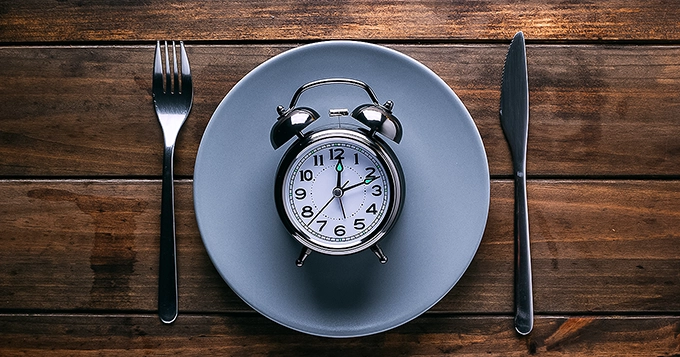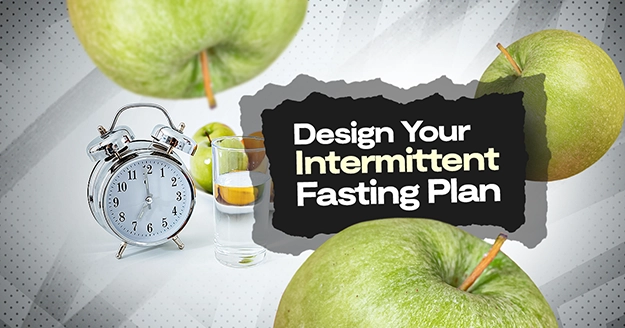Intermittent fasting (IF) has surged in popularity lately as both a weight loss technique and a means of enhancing overall well-being. By alternating eating periods with fasting periods, IF offers a flexible and sustainable approach to managing weight and promoting wellness. However, designing an intermittent fasting plan that suits your lifestyle and goals requires careful consideration and planning.
This article will share some steps to help you create your own intermittent fasting plan.
But first, let’s define intermittent fasting.
What is an Intermittent Fasting Diet Plan?
Before diving into designing your IF plan, it’s essential to understand the fundamentals of intermittent fasting.
Intermittent fasting involves cycling between periods of fasting and eating, typically with daily fasting periods ranging from 12 to 20 hours. During the fasting window, you consume little to no calories, while during the eating window, you consume all your daily calories within a specified time frame.
Considering our evolutionary history, intermittent fasting aligns with our natural inclination to endure extended periods without meals, before the advent of 24-hour drive-thrus and abundant food supplies. However, reaping its advantages hinges on crafting a personalized schedule that harmonizes with your body and metabolism, alongside mindful food choices during the eating window.
Benefits of Intermittent Fasting
Weight loss
Recent studies indicate intermittent fasting as a viable weight management approach, although it may not surpass traditional calorie restriction in efficacy. However, some individuals may find it easier to sustain over the long term. A 2017 trial comparing intermittent fasting and standard calorie restriction diets over a year found similar weight loss outcomes for both methods, with no notable differences in other health markers like blood pressure or heart rate.
Lower Risk of Type II Diabetes
Intermittent fasting shows promise in diabetes prevention by aiding weight loss and reducing insulin resistance, a hallmark of type 2 diabetes.
Weight management is particularly critical for those at risk, such as individuals with overweight or obesity, especially if they have prediabetes. While a 2022 review indicates intermittent fasting can decrease insulin resistance, its comparative effectiveness to traditional calorie restriction remains uncertain.
Contradictory findings exist, as a 2018 rat study suggested intermittent fasting might increase diabetes risk, highlighting the need for further research.
Additionally, gender differences were observed, with intermittent fasting potentially regulating blood sugar more effectively in males than females, underlining the necessity for continued investigation.
Improved Heart Health
Studies suggest that intermittent fasting may offer cardiovascular health benefits. Intermittent fasting could lead to a decrease in the following in both humans and animals:
- blood pressure
- cholesterol
- heart rate
- Triglycerides (Triglycerides are fat in the blood linked to heart disease.)
Better Brain Health
Intermittent fasting, known for its various body benefits like reducing inflammation, blood sugar levels, and insulin resistance, may also positively affect brain health.
Recent animal research from 2019 suggests that intermittent fasting could promote the growth of new nerve cells, potentially enhancing brain function.
Other animal studies have also indicated that intermittent fasting may lower the risk of neurological issues such as stroke, Alzheimer’s disease, and Parkinson’s disease.
However, further research is necessary to ascertain whether these findings can be generalized to humans.
Reduced Risk of Cancer
Animal studies suggest IF may lower the risk of cancer by delaying tumor onset. However, no conclusive evidence exists linking intermittent fasting to cancer prevention in humans.
Obesity, a risk factor for several cancers according to the World Health Organization (WHO), may be mitigated by the weight loss component of intermittent fasting, contributing to its potential cancer risk reduction.
Intermittent fasting may also decrease cancer-related biological factors like insulin levels and inflammation. While promising, human studies are needed to validate these findings.
Lower oxidative stress and inflammation
Oxidative stress, caused by unstable molecules called free radicals, damages proteins and DNA, contributing to aging and chronic diseases. According to a 2018 review, intermittent fasting may boost the body’s defense against oxidative stress. Additionally, a 2019 study suggests intermittent fasting could reduce inflammation, associated with various health conditions.
Create Your Intermittent Fasting Schedule
Here’s how:
- Set Your Goals
Determine why you want to incorporate intermittent fasting into your lifestyle. Are you seeking weight loss, better metabolic health, increased energy, or other health benefits? Setting clear and realistic goals will guide your intermittent fasting plan and help you stay motivated.
- Choose Your Fasting Schedule and Plan Your Eating Window
Choose a fasting schedule that fits well with your lifestyle, preferences, and objectives. Try out various schedules to discover the one that suits you most effectively.
Once you’ve chosen your fasting schedule, decide on the duration of your eating window. This is the time frame during which you consume all your daily calories. Be mindful of your schedule, hunger levels, and meal timing preferences when planning your eating window.
Popular Intermittent Fasting Diet Plans to Choose From
16:8 Method
The eating pattern known as the 16:8 method, or the Leangains diet, involves fasting for 16 hours each day, followed by an 8-hour eating window.
For beginners, the 16:8 method offers an accessible starting point.
This schedule can easily integrate into your daily routine without causing undue stress. For instance, if your typical day involves sleeping from 11 PM to 7 AM and working from 9 AM to 5 PM, you could set your eating window from 11 AM to 7 PM. This way, you’ll have the energy from your meals to stay focused during work hours.
Experiment with different 16:8 schedules until you find one that aligns with your lifestyle. If fasting for 16 hours feels overwhelming, you can gradually reduce the fasting window to 14 or 12 hours.
20:4 Method
After mastering the 16:8 intermittent fasting, consider advancing to the 20:4 schedule. This entails a 4-hour eating window followed by 20 hours of fasting. Aligning your eating window with typical lunch and dinner times, such as 1 PM to 5 PM for a nine-to-five schedule, is advisable. Typically, individuals consume either one substantial meal or two smaller ones during this fasting period.
5:2 Diet
The 5:2 diet involves consuming regular, healthy meals five days a week and reducing calorie consumption on the remaining two days.
Fasting days are usually spread throughout the week, with individuals choosing days such as Monday and Thursday for fasting and eating regularly on the other days. It’s advised to have at least one non-fasting day between fasting days.
Alternate Day Fasting
The alternate day fasting plan encompasses various approaches, all involving fasting every other day.
Some individuals opt for complete abstinence from solid foods on fasting days, while others allow a maximum of 500 calories. On feeding days, participants typically eat without restriction.
This method of intermittent fasting is considered extreme and may not be suitable for those with certain medical conditions or beginners. Additionally, sustaining alternate-day fasting over the long term can pose challenges.
The Warrior Diet
It involves fasting during the day and eating at night. It is a relatively extreme type of intermittent fasting.
The Warrior Diet entails consuming minimal food, often raw fruits and vegetables, within a 20-hour fasting window, followed by one substantial meal at night, typically within a 4-hour eating window. This approach may suit individuals who have experimented with other intermittent fasting methods.
Proponents suggest that humans are naturally inclined to eat at night, aligning with circadian rhythms. During the 4-hour eating phase, a balanced intake of vegetables, proteins, healthy fats, and some carbohydrates is recommended.
However, adhering to strict timing and food guidelines may be challenging long-term, and consuming a large meal close to bedtime may be difficult for some individuals.
Tips when Doing Intermittent Fasting
- Focus on Nutrient-Dense Foods: Opt for nutrient-rich foods during your eating window to ensure you receive vital vitamins, minerals, and macronutrients. Incorporate ample servings of fruits, vegetables, lean proteins, whole grains, and healthy fats into your meals to promote overall health and vitality.
- Stay Hydrated: Maintaining hydration is vital during fasting and eating intervals. Ensure adequate water intake throughout the day to prevent dehydration and sustain optimal bodily functions. Herbal teas, black coffee, and sparkling water are suitable beverage choices for most individuals during fasting periods.
- Listen to Your Body: Listen to your body’s hunger and fullness signals throughout the day. If you experience excessive hunger or fatigue during fasting periods, consider adapting your fasting schedule or eating window to better suit your needs. Striking a balance that fosters well-being and long-term sustainability is essential.
- Be Patient and Flexible: Crafting an effective intermittent fasting diet plan requires patience and perseverance. Remain adaptable and receptive to adjustments, considering your progress, bodily responses, and evolving lifestyle or objectives. Stay flexible and open-minded as you refine your intermittent fasting strategy over time.
- Monitor Your Progress: Track your intermittent fasting journey by noting physical, mental, and emotional changes. Monitor shifts in weight, body composition, energy, mood, and general well-being. Celebrate achievements and glean insights from setbacks to optimize your progress.
- Consult a Healthcare Professional: Before embarking on a new diet or lifestyle change, particularly if you have underlying health conditions, seek advice from a registered dietitian or healthcare professional. They can offer tailored guidance and assistance in crafting a safe and beneficial intermittent fasting regimen.









